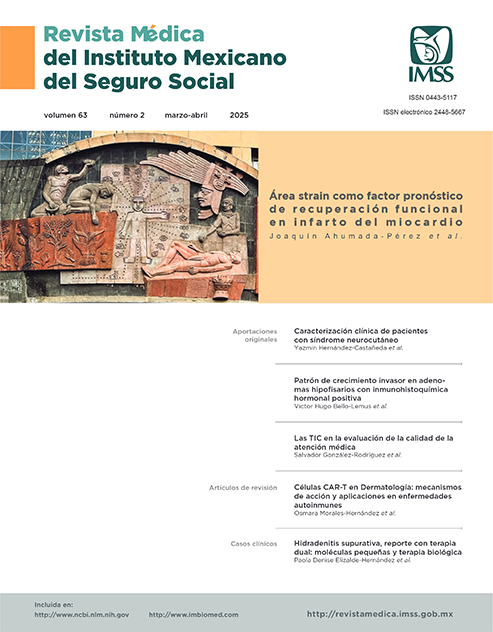Self-report of body silhouettes to discriminate high abdominal adiposity in adolescents
Main Article Content
Keywords
Body Composition, Adolescents, Body Image, Obesity, Waist Circumference
Abstract
Background: Obtaining abdominal adiposity through sel-freporting of body silhouettes could be a tool in long-distance epidemiological studies.
Objective: To determine the cut-off point of body silhouettes and evaluate their diagnostic certainty in the classification of abdominal adiposity in Mexican adolescents.
Material and methods: An analytical cross-sectional study was carried out on adolescents aged 14 to 18, high school students in the State of Mexico. The participants signed the informed consent, a body silhouette (BS) scheme was applied and their waist circumference (WC) was measured at the abdominal midpoint. Descriptive analyzes were performed, the best cut-off point was determined using ROC curves and the Youden index, and the diagnostic performance of BS to identify abdominal adiposity was evaluated.
Results: 513 students were included (57% female; median age 16 [IQR 15-17] years). BS 6 was found to be the best cut-off point for both women (Youden = 0.68) and men (Youden = 0.69). The sensitivity was 91% in women and 79% in men, the specificity was 77% in women and 89% in men, with a positive likelihood ratio of 3.92 (95%CI = 3.77, 4.08) for women and 7.08 (95%CI = 4.55, 11.0) for men.
Conclusions: Self-reported BS are a tool with high certain[1]ty that can be used to discriminate abdominal adiposity in adolescents
References
Organización Mundial de la Salud (OMS). Sobrepeso y obesidad, datos y cifras [Internet]. 2022 [citado 10 de abril de 2024]. Disponible en: https://www.who.int/es/news-room/fact-sheets/detail/obesity-and-overweight#:~:text=Datos%20y%20cifras&text=En%202022%2C%202500%20millones%20de,de%205%20a%C3%B1os%20ten%C3%ADan%20sobrepeso
Shamah-Levy T, Gaona-Pineda EB, Cuevas-Nasu L, et al. Prevalencias de sobrepeso y obesidad en población escolar y adolescente de México. Ensanut Continua 2020-2022. Salud Publica Mex. 2023;65(supl I):S218-24. doi: 10.21149/14762
Estrella R, Salazar F, Paredes Y, et al. Predictores de riesgo cardiometabólico en adolescentes de Quito. Revista de la Fac Cien Med (Quito). 2019;44(1):13-25. doi: 10.29166/ciencias_medicas.v44i1.1898
Nalini M, Sharafkhah M, Poustchi H, et al. Comparing anthropometric indicators of visceral and general adiposity as determinants of overall and cardiovascular mortality HHS public access. Arch Iran Med. 2022;22(6):301-9.
Labraña AM, Durán E, Martínez MA, et al. Menor peso corporal, de índice de masa corporal y de perímetro de cintura se asocian a una disminución en factores de riesgo cardiovascular en población chilena. Rev Med Chil. 2017;145(5):585-94. doi: 10.4067/S0034-98872017000500005
Li Y, Schoufour J, Wang DD, et al. Healthy lifestyle and life expectancy free of cancer, cardiovascular disease, and type 2 diabetes: Prospective cohort study. The BMJ. 2020;368. doi: 10.1136/bmj.l6669
Farvid MS, Holmes MD, Chen WY, et al. Postdiagnostic fruit and vegetable consumption and breast cancer survival: Prospective analyses in the nurses’ health studies. Cancer Res. 2020;80(22):5134-43. doi: 10.1158/0008-5472.CAN-18-3515
Lozano LJP, Gutiérrez DSG, Porras EAC, et al. Cross-sectional study: Alignment between anthropometric variables and their self-report. Revista Chilena de Anestesia. 2024;53(2):100-6. doi: 10.25237/REVCHILANESTV53N2-05
Rios-Leyvraz M, Ortega N, Chiolero A. Reliability of self-reported height and weight in children: a school-based cross-sectional study and a review. Nutrients. 2023;15:75. doi: 10.3390/nu15010075
Cortés-Martínez G, Vallejo-de la Cruz NL, Pérez-Salgado D, et al. Utilidad de siluetas corporales en la evaluación del estado nutricional en escolares y adolescentes de la Ciudad de México. Med Hosp Infantil Mex. 2009;66:511-21.
Blachman-Braun R, Talavera JO, Pérez-Rodríguez M, et al. Self-reported body silhouettes: a diagnostic instrument for anthropometric parameters. Public Health. 2021;200:39-46. doi: 10.1016/j.puhe.2021.09.001
Velasco-Rodríguez VM, Martínez-Ordaz VA, Roiz-Hernández J, et al. Muestreo y tamaño de muestra. Una guía práctica para personal de salud que realiza investigación. Buenos Aires: e-libro.net; 2003.
Perona JS, Schmidt-RioValle J, Fernández-Aparicio Á, et al. Waist Circumference and Abdominal Volume Index Can Predict Metabolic Syndrome in Adolescents, but only When the Criteria of the International Diabetes Federation are Employed for the Diagnosis. Nutrients. 2019;11(6). doi: 10.3390/nu11061370
Sorensen T, Stunkard A, Teasdale T, et al. The accuracy of report of weight: Children recall of their parent’s weight 15 years earlier. Int J Obes. 1983;7:115-22.
Reese TO, Bovet P, Choo-Kang C, et al. Utility of silhouette showcards to assess adiposity in three countries across the epidemiological transition. PLOS Global Public Health. 2022; 2(5):e0000127. doi: 10.1371/journal.pgph.0000127
dos Anjos LA, Ferreira Moraes C. Agreement between selfassessment of body image and measured body mass index in the Brazilian adult population. Ciencia e Saude Coletiva. 2020;25(8):3027-36. doi: 10.1590/1413-81232020258.17392018
Blachman-Braun R, Talavera JO, Pérez-Rodríguez M, et al. Risk assessment of dyslipidemias, hyperglycemia, hyperuricemia, and hypertension utilizing self-reported body silhouettes. J Obes. 2023;2023(2):1-10. doi: 10.1155/2023/4991684
Yepes M, Viswanathan B, Bovet P, et al. Validity of silhouette showcards as a measure of body size and obesity in a population in the African region: A practical research tool for general-purpose surveys. Popul Health Metr. 2015;13(1):1-9. doi: 10.1186/s12963-015-0069-6
Duno M, Acosta E. Percepción de la imagen corporal en adolescentes universitarios. Rev Chil Nutr. 2019;46(5):545-53. doi: 10.4067/S0717-75182019000500545
Liyanage G, Karunainathan T, Jeyarajah L, et al. Body image dissatisfaction and its determinants in urban Sri Lankan adolescents. Ceylon Medical Journal. 2021;66(4):185-90. doi: 10.4038/cmj.v66i4.9509
Toselli S, Grigoletto A, Zaccagni L, et al. Body image perception and body composition in early adolescents: a longitudinal study of an Italian cohort. BMC Public Health. 2021;21(1):1381. doi: 10.1186/s12889-021-11458-5
Choo-Kang C, Reese TO, Micklesfield LK, et al. Silhouette showcards confirm altered obesity-associated body image perception in international cohort study of African-origin populations. BMJ Open. 2024;14(3):e065498. doi: 10.1136/bmjopen -2022-065498
Carvalho GX, Nunes APN, Moraes CL, et al. Body image dissatisfaction and associated factors in adolescents. Ciencia e Saude Coletiva. 2020;25(7):2769-82. doi: 10.1590/1413 -81232020257.27452018
Rodríguez-Lopez S, Bajo JM. Proporción corporal, obesidad general y abdominal en adolescentes de Córdoba, Argentina. Rev Argent Antropol Biol. 2019;21(1). doi: 10.17139/raab.2019. 0021.01.06
Hoyer A, Zapf A. Studies for the evaluation of diagnostic tests: part 28 of a series on evaluation of scientific publications. Deutsches Ärzteblatt International. 2021;118:550-60. doi: 10.3238/arztebl.m2021.0224


